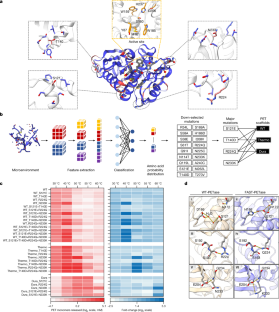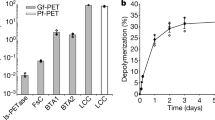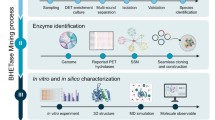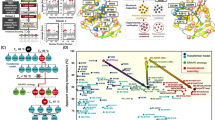Abstract
Plastic waste poses an ecological challenge1,2,3 and enzymatic degradation offers one, potentially green and scalable, route for polyesters waste recycling4. Poly(ethylene terephthalate) (PET) accounts for 12% of global solid waste5, and a circular carbon economy for PET is theoretically attainable through rapid enzymatic depolymerization followed by repolymerization or conversion/valorization into other products6,7,8,9,10. Application of PET hydrolases, however, has been hampered by their lack of robustness to pH and temperature ranges, slow reaction rates and inability to directly use untreated postconsumer plastics11. Here, we use a structure-based, machine learning algorithm to engineer a robust and active PET hydrolase. Our mutant and scaffold combination (FAST-PETase: functional, active, stable and tolerant PETase) contains five mutations compared to wild-type PETase (N233K/R224Q/S121E from prediction and D186H/R280A from scaffold) and shows superior PET-hydrolytic activity relative to both wild-type and engineered alternatives12 between 30 and 50 °C and a range of pH levels. We demonstrate that untreated, postconsumer-PET from 51 different thermoformed products can all be almost completely degraded by FAST-PETase in 1 week. FAST-PETase can also depolymerize untreated, amorphous portions of a commercial water bottle and an entire thermally pretreated water bottle at 50 ºC. Finally, we demonstrate a closed-loop PET recycling process by using FAST-PETase and resynthesizing PET from the recovered monomers. Collectively, our results demonstrate a viable route for enzymatic plastic recycling at the industrial scale.
This is a preview of subscription content, access via your institution
Access options
Access Nature and 54 other Nature Portfolio journals
Get Nature+, our best-value online-access subscription
$29.99 / 30 days
cancel any time
Subscribe to this journal
Receive 51 print issues and online access
$199.00 per year
only $3.90 per issue
Buy this article
- Purchase on Springer Link
- Instant access to full article PDF
Prices may be subject to local taxes which are calculated during checkout




Similar content being viewed by others
Data availability
The authors declare that all data supporting the findings of this study are available in the article, its Extended Data, its Source Data or from the corresponding authors upon request. The complete data set of MutCompute predictions used in this study can be acquired at https://mutcompute.com. Coordinates for the FAST-PETase structure have been deposited into the PDB with accession code 7SH6. Interactive visualizations of MutCompute for Fig. 1 are available at https://www.mutcompute.com/petase/5xjh and https://www.mutcompute.com/petase/6ij6. Source data are provided with this paper.
Code availability
MutCompute and MutCompute-View are publicly available at https://mutcompute.com and https://mutcompute.com/view for academic research.
References
Geyer, R., Jambeck, J. R. & Law, K. L. Production, use, and fate of all plastics ever made. Sci. Adv. 3, e1700782 (2017).
Santos, R. G., Machovsky-Capuska, G. E. & Andrades, R. Plastic ingestion as an evolutionary trap: toward a holistic understanding. Science 373, 56–60 (2021).
MacLeod, M., Arp, H. P. H., Tekman, M. B. & Jahnke, A. The global threat from plastic pollution. Science 373, 61–65 (2021).
Chen, C. C., Dai, L., Ma, L. & Guo, R. T. Enzymatic degradation of plant biomass and synthetic polymers. Nat. Rev. Chem. 4, 114–126 (2020).
George, N. & Kurian, T. Recent developments in the chemical recycling of postconsumer poly(ethylene terephthalate) waste. Ind. Eng. Chem. Res. 53, 14185–14198 (2014).
Simon, N. et al. A binding global agreement to address the life cycle of plastics. Science 373, 43–47 (2021).
Kawai, F., Kawabata, T. & Oda, M. Current knowledge on enzymatic PET degradation and its possible application to waste stream management and other fields. Appl. Microbiol. Biotechnol. 103, 4253–4268 (2019).
Sarah, K. & Gloria, R. Achieving a circular bioeconomy for plastics. Science 373, 49–50 (2021).
Ru, J., Huo, Y. & Yang, Y. Microbial degradation and valorization of plastic wastes. Front. Microbiol. https://doi.org/10.3389/fmicb.2020.00442 (2020).
Ellis, L. D. et al. Chemical and biological catalysis for plastics recycling and upcycling. Nat. Catal. 4, 539–556 (2021).
Taniguchi, I. et al. Biodegradation of PET: current status and application aspects. ACS Catal. https://doi.org/10.1021/acscatal.8b05171 (2019).
Tournier, V. et al. An engineered PET depolymerase to break down and recycle plastic bottles. Nature 580, 216–219 (2020).
Inderthal, H., Tai, S. L. & Harrison, S. T. L. Non-hydrolyzable plastics – an interdisciplinary look at plastic bio-oxidation. Trends Biotechnol. 39, 12–23 (2021).
Yoshida, S. et al. A bacterium that degrades and assimilates poly(ethylene terephthalate). Science 351, 1196–1199 (2016).
Chen, C. C. et al. General features to enhance enzymatic activity of poly(ethylene terephthalate) hydrolysis. Nat. Catal. https://doi.org/10.1038/s41929-021-00616-y (2021).
Worm, B., Lotze, H. K., Jubinville, I., Wilcox, C. & Jambeck, J. Plastic as a persistent marine pollutant. Ann. Rev. Env. Resourc.https://doi.org/10.1146/annurev-environ-102016-060700 (2017).
Son, H. F. et al. Rational protein engineering of thermo-stable PETase from Ideonella sakaiensis for highly efficient PET degradation. ACS Catal. 9, 3519–3526 (2019).
Austin, H. P. et al. Characterization and engineering of a plastic-degrading aromatic polyesterase. Proc. Natl Acad. Sci. USA 115, E4350–E4357 (2018).
Joo, S. et al. Structural insight into molecular mechanism of poly(ethylene terephthalate) degradation. Nat. Commun. 9, 382 (2018).
Han, X. et al. Structural insight into catalytic mechanism of PET hydrolase. Nat. Commun. 8, 2106 (2017).
Furukawa, M., Kawakami, N., Oda, K. & Miyamoto, K. Acceleration of enzymatic degradation of poly(ethylene terephthalate) by surface coating with anionic surfactants. Chem. Sus. Chem. 11, 4018–4025 (2018).
Cui, Y. et al. Computational redesign of a PETase for plastic biodegradation under ambient condition by the GRAPE strategy. ACS Catal. https://doi.org/10.1021/acscatal.0c05126 (2021).
Chen, K., Hu, Y., Dong, X. & Sun, Y. Molecular insights into the enhanced performance of ekylated petase toward PET degradation. ACS Catal. 11, 7358–7370 (2021).
Shroff, R. et al. Discovery of novel gain-of-function mutations guided by structure-based deep learning. ACS Synth. Biol. 9, 2927–2935 (2020).
Kawai, F. et al. A novel Ca2+-activated, thermostabilized polyesterase capable of hydrolyzing polyethylene terephthalate from Saccharomonospora viridis AHK190. Appl. Microbiol. Biotechnol. 98, 10053–10064 (2014).
Weissmann, D. Applied Plastics Engineering Handbook: Processing, Materials, and Applications 2nd edn (ed. Kutz, M.) 717–741 (William Andrew Publishing, 2017).
Wallace, N. E. et al. The highly crystalline PET found in plastic water bottles does not support the growth of the PETase-producing bacterium Ideonella sakaiensis. Environ. Microbiol. Rep. 12, 578–582 (2020).
Wei, R. & Zimmermann, W. Microbial enzymes for the recycling of recalcitrant petroleum-based plastics: how far are we? Microb. Biotechnol. 10, 1308–1322 (2017).
Kawai, F., Kawabata, T. & Oda, M. Current state and perspectives related to the polyethylene terephthalate hydrolases available for biorecycling. ACS Sustain. Chem. Eng. 8, 8894–8908 (2020).
Otwinowski, Z. & Minor, W. Processing of X-ray diffraction data collected in oscillation mode. Methods Enzymol. 276, 307–326 (1997).
Emsley, P. & Cowtan, K. Coot: model-building tools for molecular graphics. Acta Crystallogr. D. Biol. Crystallogr. 60, 2126–2132 (2004).
Liebschner, D. et al. Macromolecular structure determination using X-rays, neutrons and electrons: recent developments in Phenix. Acta Crystallogr. Sect. D, Struct. Biol. 75, 861–877 (2019).
Fujita, M. et al. Cloning and nucleotide sequence of the gene (amyP) for maltotetraose-forming amylase from Pseudomonas stutzeri MO-19. J. Bacteriol. 171, 1333–1339 (1989).
Leonard, S. P. et al. Genetic engineering of bee gut microbiome bacteria with a toolkit for modular assembly of broad-host-range plasmids. ACS Synth. Biol. 7, 1279–1290 (2018).
Acknowledgements
This work was financed under research agreement no. EM10480.26/UTA16-000509 between the ExxonMobil Research and Engineering Company and The University of Texas at Austin. Sequencing was conducted at the Genomic Sequencing and Analysis Facility (RRID no. SCR_021713), SEM was conducted at the Microscopy and Imaging Facility (RRID no. SCR_021756) at the UT Austin Center for Biomedical Research Support, and AFM analysis was conducted at the Texas Materials Institute at UT Austin. N.A.L. and C.Z. thank the Welch Foundation for partial support of this research (Grant #F-1904). The crystallography study is supported by a grant from the National Institutes of Health (no. GM104896 to Y.J.Z.). Crystallographic data collections were conducted at Advanced Photon Sources (BL23-ID-B), Department of Energy national user facility. We acknowledge the Texas Advanced Computing Center at The University of Texas at Austin for providing deep learning resources for neural network predictions and analysis that have contributed to the research results reported in this paper.
Author information
Authors and Affiliations
Contributions
H.S.A., A.D.E., N.A.L. and H.L. designed and directed the research. In investigation and validation, R.S. and D.J.D. performed neural network analysis. H.L. performed enzyme engineering, purification and the depolymerization experiments of both model and pc-PET substrates. H.L., N.J.C., C.Z., D.J.A. and H.O.C. carried out structural and physical characterization of variants. H.L., C.Z. and N.J.C. performed physical characterization of the treated and untreated commercial PET materials. C.Z carried out experiments for purifying TPA and regenerating virgin PET and plastics films. D.J.D. and B.R.A. developed MutCompute-View for visualizing predictions from the neural network model. W.K. and Y.J.Z. performed protein crystallization and structural analysis of the engineered enzyme. H.S.A. and H.L. wrote the original draft of the manuscript. H.S.A., A.D.E., N.A.L. and H.L. revised the manuscript. H.S.A. and A.D.E. conceived the project idea. All authors reviewed and accepted the manuscript.
Corresponding author
Ethics declarations
Competing interests
A patent has been filed in 2020, ‘Mutations for improving activity and thermostability of PETase enzymes’ relating to the mutants and applications developed in this study. R.S. is a cofounder of Aperiam, a company that applies machine learning to protein engineering. R.S. and A.D.E. are inventors on a patent for applying machine learning to protein engineering that has been licensed to Aperiam.
Peer review
Peer review information
Nature thanks Gregory Bowman, Ulphard Thoden van Velzen and the other, anonymous, reviewer(s) for their contribution to the peer review of this work.
Additional information
Publisher’s note Springer Nature remains neutral with regard to jurisdictional claims in published maps and institutional affiliations.
Extended data figures and tables
Extended Data Fig. 1 Top 10 MutCompute predictions ranked by fold change in the probabilities between the predicted and the wild-type amino acid.
The top 10 mutations predicted using the wild-type PETase (a) and ThermoPETase (b) as scaffolds are presented. MutCompute is an ensembled model that consist of three individually trained 3-dimensional convolutional neural network (3DCNN) models. Thus, the avg_log_ratio column is the average of the three log ratio values obtained from the three 3DCNN models, rather than being the log ratio of the average probability assigned to the wild type and predicted amino acid across the three 3DCNN models.
Extended Data Fig. 2 Thermostability and protein yield of the PETase variants incorporating the predicted mutations and their respective scaffolds—wild-type PETase (WT), ThermoPETase (Thermo), DuraPETase (Dura).
Tm of each enzyme (left) was determined by DSC. The protein yield of each enzyme (right) from P. putida purification experiments was evaluated using a Bradford protein assay. All measurements were conducted in triplicate (n = 3). The bars shown represent the average numbers.
Extended Data Fig. 3 X-ray crystal structure of FAST-PETase.
a, Overall crystal structure of FAST-PETase. Catalytic triads (S160, D206, H237) are shown in blue sticks. Mutations originating from or shared with ThermoPETase (S121E, D186H, R280A) are shown in pink sticks, and completely novel mutations predicted by MutCompute are shown in green-yellow sticks. b, c, 2Fo-Fc map (contoured at 1.5 σ) shown as grey mesh superimposed on the stick models of novel mutation sites (b) R224Q, (c) N233K.
Extended Data Fig. 4 Location of the LM site in the crystal structures of homologous PHEs.
On wild-type PETase from I. Sakaiensis (white ribbon), catalytic residues are shown as blue sticks. LM site is shown as gray sticks on top of cartoon representation. LM site is zoomed in to show superimposed structures of four different homologous PHEs (right top panel: WT): I. Sakaiensis wild-type PETase (gray sticks, PDB code 5XJH), LCC (yellow sticks, PDB code 4EB0), LCCF243I/D238C/S283C/N246M (ICCM) (green sticks, PDB code 6THT - LCCF243I/D238C/S283C/Y127G (ICCG) variant structure), and S. viridis Cut190 (pink sticks, PDB code 4WFI - Cut190S226P variant structure). Based on FAST-PETase structure, the structure of homologous PHEs with LM is modelled (right bottom panel: LM) with residues shown as blue-colored sticks.
Extended Data Fig. 5 Time-course of mass loss and PET monomers released from hydrolyzing the hole-punched films of six representative pc-PET products with FAST-PETase.
The six pc-PET products represent PET #2, 6, 8, 25, 29, 32 that were randomly selected from the 51 pc-PET products (Supplementary Table 3 and Supplementary Fig. 4). The pc-PET films hole-punched from these PET products were hydrolysed by serial treatment with FAST-PETase at 50 °C until the films were completely degraded (film disappeared). Enzyme solution (200 nM of FAST-PETase in 100 mM KH2PO4-NaOH (pH 8.0) buffer) was replenished every 22 h. All measurements were conducted in triplicate (n = 3). The squares (mass loss) and circles (PET monomers released) shown represent the individual numbers. The line connects mean values of the timepoints.
Extended Data Fig. 6 Scatterplot of time needed for complete degradation versus initial mass of the hole-punched films from 51 different pc-PET products.
Degradation time was found to be corelated with the thickness (as thickness and mass are related) of the hole-punched films from various plastic products.
Extended Data Fig. 7 Scatterplot of degradation rate versus (a.) initial mass, (b.) crystallinity%, (c.) weight average molecular weight (Mw), (d.) number average molecular weight (Mn), or (e.) polydispersity indices of the hole-punched films from 51 different pc-PET products.
Degradation rate was not found to be dependent on any one metric across these various pc-PET plastics.
Extended Data Fig. 8 Scanning electron microscopic analysis of the pc-PET films.
The hole-punched PET films from a bean cake PET container were treated with FAST-PETase for 0 h, 8 h, 16 h in 100 mM KH2PO4-NaOH (pH 8.0) buffer at 50 °C.
Extended Data Fig. 9 Depolymerization of the Finish/Neck, Body and Base Center fragments of an untreated water bottle.
Depolymerization was tested by FAST-PETase, wild-type PETase (WT), ThermoPETase (Thermo), DuraPETase (Dura), LCC and ICCM at (a) 50 ºC, (b) 60 ºC, and (c) 72 ºC. All measurements were conducted in triplicate (n = 3). The bars and circles shown for each enzyme represent the average and individual numbers, respectively. This comparative analysis provides two main conclusions. First, although higher reaction temperatures do promote the hydrolytic activity of the thermophilic LCC and ICCM against the amorphous parts of the bottle (base center and finish), the highly crystalline body part still cannot be efficiently depolymerized by any tested enzymes and temperatures. Second, FAST-PETase at 50 ºC exhibited the highest overall depolymerization rate seen in these experiments releasing 42, 0.14 and 15 mM of PET monomers within 24 h against the finish, body, and bottom center of the bottle respectively. These values are 25%, 43% and 20% higher, respectively, than that of ICCM at 72 ºC.
Supplementary information
Supplementary Information
This file contains Supplementary Methods, Discussion; Tables 1–3 and Figs. 1–13.
Rights and permissions
About this article
Cite this article
Lu, H., Diaz, D.J., Czarnecki, N.J. et al. Machine learning-aided engineering of hydrolases for PET depolymerization. Nature 604, 662–667 (2022). https://doi.org/10.1038/s41586-022-04599-z
Received:
Accepted:
Published:
Issue Date:
DOI: https://doi.org/10.1038/s41586-022-04599-z
This article is cited by
-
Enzyme engineering for functional lipids synthesis: recent advance and perspective
Bioresources and Bioprocessing (2024)
-
ATP-free in vitro biotransformation of starch-derived maltodextrin into poly-3-hydroxybutyrate via acetyl-CoA
Nature Communications (2024)
-
Machine learning for functional protein design
Nature Biotechnology (2024)
-
Accelerating the design of pili-enabled living materials using an integrative technological workflow
Nature Chemical Biology (2024)
-
Potential routes of plastics biotransformation involving novel plastizymes revealed by global multi-omic analysis of plastic associated microbes
Scientific Reports (2024)
Comments
By submitting a comment you agree to abide by our Terms and Community Guidelines. If you find something abusive or that does not comply with our terms or guidelines please flag it as inappropriate.



